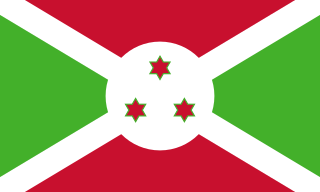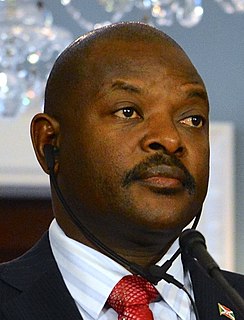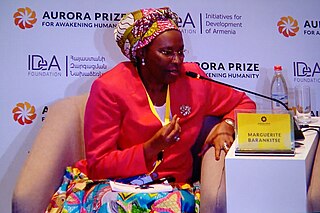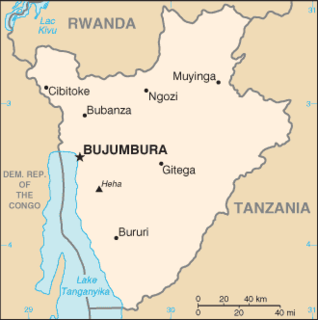The BurundiNational Defence Force is the state military organisation responsible for the defence of Burundi.

Burundi is one of the few countries in Africa to be a direct territorial continuation of a pre-colonial era African state.

Michel Micombero was a Burundian politician and army officer who ruled the country as its first president and de facto dictator for the decade between 1966 and 1976.

Domitien Ndayizeye is a Burundian politician who was President of Burundi from 2003 to 2005. He succeeded Pierre Buyoya, as president on 30 April 2003, after serving as Buyoya's vice president for 18 months. Ndayizeye remained in office until succeeded by Pierre Nkurunziza on 26 August 2005.

The Front for Democracy in Burundi is a Hutu progressive political party in Burundi.

Princess Esther Kamatari is a writer, model, and exiled Burundian princess.

The Burundian Civil War was a civil war in Burundi lasting from 1993 to 2005. The civil war was the result of long standing ethnic divisions between the Hutu and the Tutsi ethnic groups in Burundi. The conflict began following the first multi-party elections in the country since independence from Belgium in 1962, and is seen as formally ending with the swearing in of Pierre Nkurunziza in August 2005. Children were widely used by both sides in the war. The estimated death toll stands at 300,000.

Pierre Nkurunziza was a Burundian politician who served as the ninth president of Burundi for almost 15 years from August 2005 until his death in June 2020. A member of the Hutu ethnic group, Nkurunziza taught physical education before becoming involved in politics during the Burundian Civil War as part of the rebel National Council for the Defense of Democracy – Forces for the Defense of Democracy (CNDD–FDD) of which he became leader in 2000. The CNDD–FDD became a political party at the end of the Civil War and Nkurunziza was elected president. He held the post controversially for three terms, sparking significant public unrest in 2015. He announced his intention not to stand for re-election in 2020 and instead ceded power to Évariste Ndayishimiye, whose candidacy he had endorsed. He died unexpectedly on 8 June 2020 shortly before the official end of his term. He was the longest-ruling president in Burundian history.

The Kingdom of Burundi or Kingdom of Urundi was a polity ruled by a traditional monarch in modern-day Republic of Burundi in the Great Lakes region of East Africa. The kingdom, majority ethnic Hutu, was ruled by a Ganwa monarch from the Tutsi ethnic group with the title of mwami. Created in the 17th century, the kingdom was preserved under European colonial rule in the late 19th and early 20th century and was an independent state between 1962 and 1966.
Prince Godefroid Kamatari was a grandson of Mwami Mutaga IV Mbikije of Burundi, and a son of Prince Ignace Kamatari and his second wife Princess Agrippine.

Marguerite (Maggie) Barankitse is a humanitarian activist who works to improve the welfare of children and challenge ethnic discrimination in Burundi. After rescuing 25 children from a massacre, she was forced to witness the conflicts between the Hutu and Tutsi in her country in 1993. She established Maison Shalom, a shelter that provided access to healthcare, education, and culture to over 20,000 orphan children in need. Because she protested against a third term for President Nkurunziza, she lives in exile.

The 1993 mass killings of Tutsis by the majority-Hutu populace in Burundi are described as genocide in the final report of the International Commission of Inquiry for Burundi presented to the United Nations Security Council in 1996.

The National Forces of Liberation is a political party and former rebel group in Burundi. An ethnic Hutu group, the party was previously known as the Party for the Liberation of the Hutu People and adhered to a radical Hutu Power ideology, but since the mid- to late-2000s has moderated its stance and cooperated with the Tutsi-supported Union for National Progress party in opposition to the rule of Pierre Nkurunziza and the CNDD-FDD.

Burundi, officially the Republic of Burundi, is a landlocked country in the Great Rift Valley where the African Great Lakes region and East Africa converge. It is bordered by Rwanda to the north, Tanzania to the east and southeast, and the Democratic Republic of the Congo to the west; Lake Tanganyika lies along its southwestern border. The capital cities are Gitega and Bujumbura.
These are some of the articles related to Burundi on the English Wikipedia:

Ethnic groups in Burundi include the three main indigenous groups of Hutu, Tutsi and Twa that have largely been emphasized in the study of the country's history due to their role in shaping it through conflict and consolidation. Burundi's ethnic make-up is similar to that of neighboring Rwanda. Additionally, recent immigration has also contributed to Burundi's ethnic diversity. Throughout the country's history, the relation between the ethnic groups has varied, largely depending on internal political, economic and social factors and also external factors such as colonialism. The pre-colonial era, despite having divisions between the three groups, saw greater ethnic cohesion and fluidity dependent on socioeconomic factors. During the colonial period under German and then Belgian rule, ethnic groups in Burundi experienced greater stratifications and solidification through biological arguments separating the groups and indirect colonial rule that increased group tensions. The post-independence Burundi has experienced recurring inter-ethnic violence especially in the political arena that has, in turn, spilled over to society at large leading to many casualties throughout the decades. The Arusha Agreement served to end the decades-long ethnic tensions, and the Burundian government has stated commitment to creating ethnic cohesion in the country since, yet recent waves of violence and controversies under the Pierre Nkurunziza leadership have worried some experts of potential resurfacing of ethnic violence. Given the changing nature of ethnicity and ethnic relations in the country, many scholars have approached the topic theoretically to come up with primordial, constructivist and mixed arguments or explanations on ethnicity in Burundi.

The 1996 Burundian coup d'état was a military coup d'état that took place in Burundi on 25 July 1996. In the midst of the Burundi Civil War, former president Pierre Buyoya deposed Hutu President Sylvestre Ntibantunganya. According to Amnesty International, in the weeks following the coup, more than 6,000 people were killed in the country. This was Buyoya's second successful coup, having overthrown Jean-Baptiste Bagaza in 1987.

On 18–19 October 1965, a group of ethnic Hutu officers from the Burundian military attempted to overthrow Burundi's government in a coup d'état. The rebels were angry about the apparent favouring of ethnic Tutsi minority by Burundi's monarchy after a period of escalating ethnic tension following national independence from Belgium in 1962. Although the Prime Minister was shot and wounded, the coup failed and soon provoked a backlash against Hutu in which thousands of people, including the participants in the coup, were killed. The coup also facilitated a militant Tutsi backlash against the moderate Tutsi monarchy resulting in two further coups which culminated in the abolition of Burundi's historic monarchy in November 1966 and the rise of Michel Micombero as dictator.

The Ikiza or the Ubwicanyi (Killings) was a genocide which was committed in Burundi in 1972 by the Tutsi-dominated army and government against the Hutus who lived in the country. Conservative estimates place the death toll of the genocide between 100,000 and 150,000 killed, while some estimates of the genocide's death toll go as high as 300,000.












